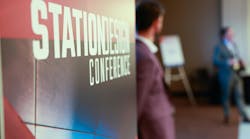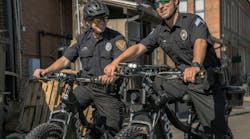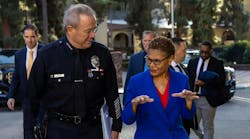When Henry Montelongo found out he wasn't going to inherit his late father's fortune, he stormed out of the attorney's office. A few minutes later, his wife dialed 911 after Montelongo grabbed a handgun and drove off. Montelongo's wife told dispatch he may be headed to his father's business.
The office staff at his father's business was accustomed to Montelongo's rudeness and bizarre behavior, but they fled the warehouse when he walked past a row of cubicles with a gun tucked in his waistband.
The parking lot leading up to the front of the warehouse was barren except for a single light pole. Officer Diaz was assigned to cover the front of the warehouse while his colleagues covered the rear exit.
When Montelongo stepped out of the front of the building, Diaz had already gone prone, recognizing that the thin light post was not reassuring cover, but its concrete base was. Diaz went through the multitasking motions unique to police work: giving decisive commands, communicating on the radio and keeping the gun on the suspect all while maintaining the prone position. Officer Diaz's use of the prone position kept him behind cover and gave him the tactical advantage.
For the rifle competitor, the prone position is the most accurate and predictable of shooting platforms. It is also the platform from which all other shooting skills should be learned. The rifle competitor creates a marriage among his shooting platform, the ground and the rifle to steady the shot.
The priorities of going prone for law enforcement shooting should be to cover, conceal, prolong deployment and stabilize, emphasizing a balance between minimum exposure and mobility. Officers with a pistol do not go prone to slowly squeeze off a precision shot, but instead they are responding to a particular tactical situation. If the officer must use cover that is less than a couple of feet tall, as in Diaz's scenario, going prone is a viable option.
In all environments, including urban, rural and natural, structures offer more bullet resistance closest to the ground. Most trees have their thickest taper near the roots. Most man-made objects, even decorative ones like columns and posts, will have the majority of their architectural strength closest to the base. Officers should choose the thickest cover, especially if the composition of the material is questionable.
Firing close to the ground will kick up dust and muzzle flash can be exaggerated, which may compromise the location of the concealed officer. If the tactical situation allows, backing up prevents oblique angle observers from getting a fix on the prone user's position.
Three variationsThere are three major types of prone firing positions: Olympic, military and rollover prone. The Olympic prone position is designed for slow-controlled accuracy. Shooters bring their elbows close together, raising the head, neck and some of the torso off the ground. The firing-side hip is raised slightly off the ground by bending one knee.
The Olympic prone position is for slow firing where accuracy has a higher priority over shooter protection. That is, one can safely fire from behind cover in this manner, but the officer's vest offers no protection and the forehead is in high profile.
The military prone position uses both legs extended behind the body with the chest, hips and knees squarely placed on the ground. It is designed to get the majority of the body behind minimal cover. Going military prone is simple and users will resort to it naturally. It is a viable solution for many situations, except that it requires the user to crane his or her neck and hold it.
The rollover prone position is comfortable and can be applied for sustained ops. Officers rest their head on the shooting arm, lowering the profile and steadying the shot. For a right handed shooter, the right cheek touches the right shoulder and bicep. The non-firing side leg is bent, getting the diaphragm off the ground and keeping objects in the front of the officer's belt from impeding the shot. It is easier to assume and provides a quicker recovery to effect the arrest.
To assume a good rollover prone position, officers begin with the hand on the firearm. If it is holstered, the draw begins. If the gun is unholstered, it should be directed toward the greatest threat.
Officers continue the draw and ensure that the muzzle is always the furthest point away from the body, directed at the threat. First, the officer assumes a kneeling position. Officers may kneel one- or two-kneed. Using the non-firing hand for support, extend the body directly in front of the kneeling position. Completely extend the firing hand while simultaneously lowering the body with the non-firing hand. With the body completely on the ground, assume a two-handed grip.
After the shooter makes contact with the ground, the non-firing knee is flexed. This causes the body to "rollover" onto only about a quarter of the body. From this leg position, some shooters prefer to put the shooting instep over the non-firing leg, creating a triangle with the legs.
The rollover allows the shooter's cheek to rest snugly on the shooting-side bicep, a position that can be maintained for an extended period of time.
Recovering from the rollover prone is a reversal of the process, punctuated by "checking the six" (scanning the rear for additional threats) at each change in viewing level. First, officers should scan forward, never breaking from cover prematurely. Second, scan the periphery, pushing off with the non-firing hand to the kneeling position. From kneeling, the officer scans first, and then pushes off the non-firing knee with the non-firing hand.
As the officer rises from prone, the option to return to prone or increase mobility by rising should be available. Putting the sole of the non-firing knee on the ground first allows the shooter to naturally transition and finish in a bladed stance.
How to PracticeUsing the prone position requires fitness level and shooting ability. The best way to prepare for prone shooting is to do it the same way the military does: push-ups and upper body conditioning. All military training emphasizes a level of upper body fitness. Officers who go from prone to standing a few times in a row will recognize the utility of this emphasis. Officers also need practice recognizing the canting of the sight picture in the prone position, which may affect accuracy.
Officers should use partner training to critique another's ability to engage targets while presenting a minimum target. The red-tipped airsoft handguns from Pyramyd Air used in the photographs are dimensionally identical to the real thing. They fit the same holsters and operate in a similar fashion. Using partners and airsoft guns, officers can use full facial protection and padding to drive home the concept of minimum exposure. The sting of the airsoft pellet is a sharp reminder, especially on an extremity that was thought to be covered.
Officers need to practice with their duty firearms on targets at the limits of their engagement range. Going prone generally accompanies the assumption that the officer may have to make a longer, more accurate shot. The rollover prone position slightly changes the sight picture and usually cants the firearm a little.
If the face is on the bicep and the body is canted, the gun can naturally cant a few degrees from vertical, causing the sight picture to differ from shooting positions.
Officers must also dry fire the prone position often enough to avoid flexing the bicep while squeezing the trigger.
The prone position has limited but essential duty in the law enforcement arsenal. Used correctly, it allows officers such as Diaz to find the balance between mobility and cover among other devices in the tactical toolbox.
Lindsey Bertomen is a retired police officer who teaches administration of Justice at Hartnell College in Salinas, California. He may be reached at [email protected].


